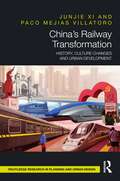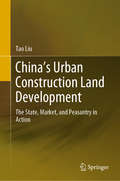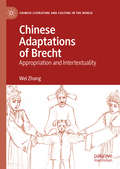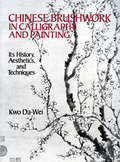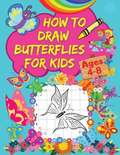- Table View
- List View
China’s Heritage through History: Reconfigured Pasts
by Yujie ZhuChina’s Heritage through History employs a longue durée approach to examine China’s heritage through history. From Imperial to contemporary China, it explores the role of practices and material forms of the past in shaping social transformation through knowledge production and transmission.The art of collecting, reproducing, and reinterpreting the past has been an enduring force shaping cultural identity and political legitimacy in China. Offering a unique, non-Western perspective on the history of heritage in China, Zhu considers who the key players have been in these ongoing processes of reconfigured pasts, what methods they have employed, and how these practices have shaped society at large. The book tackles these questions by delving into the transformation of practices related to heritage through examples such as the book collection at Tianyi Private Library, the reproduction of the Orchid Pavilion Preface calligraphy and its associated sites, and the dynamics of exchange within the Liulichang antique market. Zhu reveals how these practices, once reserved for elites, have become accessible to the broader public. These processes of transformation, embodied in various forms of reconfigured pasts, have given rise to modern approaches to preservation, digitisation, museums, and the burgeoning heritage tourism industry.China’s Heritage through History will be an invaluable resource for academics, students, and practitioners working in the fields of heritage, museum studies, and art history.
China's iGeneration: Cinema and Moving Image Culture for the Twenty-First Century
by Matthew D. Johnson Keith B. Wagner Kiki Tianqi Yu Luke VulpianiThis innovative collection of essays on twenty-first century Chinese cinema and moving image culture features contributions from an international community of scholars, critics, and practitioners. Taken together, their perspectives make a compelling case that the past decade has witnessed a radical transformation of conventional notions of cinema. Following China's accession to the WTO in 2001, personal and collective experiences of changing social conditions have added new dimensions to the increasingly diverse Sinophone media landscape, and provided a novel complement to the existing edifice of blockbusters, documentaries, and auteur culture. The numerous 'iGeneration' productions and practices examined in this volume include 3D and IMAX films, experimental documentaries, animation, visual aides-mémoires, and works of pirated pastiche. Together, they bear witness to the emergence of a new Chinese cinema characterized by digital and, trans-media representational strategies, the blurring of private/public distinctions, and dynamic reinterpretations of the very notion of 'cinema' itself.
China's Porcelain Capital: The Rise, Fall and Reinvention of Ceramics in Jingdezhen
by Maris Boyd GilletteMaris Boyd Gillette's groundbreaking study tells the story of Jingdezhen, China's porcelain capital, from its origins in 1004 in Song dynasty China to the present day.Gillette explores how Jingdezhen has been affected by state involvement in porcelain production, particularly during the long 20th century. She considers how the Chinese government has consumed, invested in, taxed and managed the local ceramics industry, and the effects of this state intervention on ceramists' lives, their local environment and the nature of the goods they produce. Gillette traces how Jingdezhen experienced the transition from imperial rule to state ownership under communism, the changing fortunes of the ceramics industry in the early 21st century, the decay and decline that accompanied privatisation, and a revival brought about by an entrepreneurial culture focusing on the manufacture of highly-prized 'art porcelain'.
China's Porcelain Capital: The Rise, Fall and Reinvention of Ceramics in Jingdezhen
by Maris Boyd GilletteMaris Boyd Gillette's groundbreaking study tells the story of Jingdezhen, China's porcelain capital, from its origins in 1004 in Song dynasty China to the present day.Gillette explores how Jingdezhen has been affected by state involvement in porcelain production, particularly during the long 20th century. She considers how the Chinese government has consumed, invested in, taxed and managed the local ceramics industry, and the effects of this state intervention on ceramists' lives, their local environment and the nature of the goods they produce. Gillette traces how Jingdezhen experienced the transition from imperial rule to state ownership under communism, the changing fortunes of the ceramics industry in the early 21st century, the decay and decline that accompanied privatisation, and a revival brought about by an entrepreneurial culture focusing on the manufacture of highly-prized 'art porcelain'.
China’s Railway Transformation: History, Culture Changes and Urban Development
by Junjie Xi Paco Mejias VillatoroThis book investigates China’s railway transformation through history, along with culture changes and urban development. The book begins by looking at the background of China and the history and growth of railway development in China through five key phases, followed by assessing the cultural changes in the railway carriage and exploring how these are linked to social equality and national provisions. The core of this book aims to analyse the Chinese urban transformation through the development of the high-speed rail (HSR) infrastructure in China. Eleven important new HSR stations in mainland China, plus the new Hong Kong West Kowloon Station, have been selected to contextually explore how HSR infrastructures have affected the development of the Chinese urban context. The selected case studies are the stations of Beijing South, Wuhan, Shanghai Hongqiao, Guangzhou South, Xi’an North, Nanjing South, Chengdu East, Tianjin West, Zhengzhou East, Hangzhou East and Hong Kong West Kowloon. All of these were built between 2008 and 2018. In these case studies, the location and the intentions and success of promoting urban development are analysed and assessed. Following this, the book further investigates the peculiarities of the new HSR stations in China in comparison with stations in Europe. An assessment framework is established to evaluate the Chinese case studies comparatively with significant cases in Europe, attending to the urban structure of the area, the architectural quality, the functional diversity and the quality of the public space generated in the surrounding area.
China’s Railway Transformation: History, Culture Changes and Urban Development
by Junjie Xi Paco Mejias VillatoroThis book investigates China’s railway transformation through history, along with culture changes and urban development. The book begins by looking at the background of China and the history and growth of railway development in China through five key phases, followed by assessing the cultural changes in the railway carriage and exploring how these are linked to social equality and national provisions. The core of this book aims to analyse the Chinese urban transformation through the development of the high-speed rail (HSR) infrastructure in China. Eleven important new HSR stations in mainland China, plus the new Hong Kong West Kowloon Station, have been selected to contextually explore how HSR infrastructures have affected the development of the Chinese urban context. The selected case studies are the stations of Beijing South, Wuhan, Shanghai Hongqiao, Guangzhou South, Xi’an North, Nanjing South, Chengdu East, Tianjin West, Zhengzhou East, Hangzhou East and Hong Kong West Kowloon. All of these were built between 2008 and 2018. In these case studies, the location and the intentions and success of promoting urban development are analysed and assessed. Following this, the book further investigates the peculiarities of the new HSR stations in China in comparison with stations in Europe. An assessment framework is established to evaluate the Chinese case studies comparatively with significant cases in Europe, attending to the urban structure of the area, the architectural quality, the functional diversity and the quality of the public space generated in the surrounding area.
China’s Urban Construction Land Development: The State, Market, and Peasantry in Action
by Tao LiuThis book examines the nature and internal dynamics of China’s urban construction land (UCL) development, drawing insights from the recently developed theory of regional political ecology. Based on the author’s original research, it identifies two different types of UCL development in China, namely top-down, formal development in the legal and regulated domain, and spontaneous and informal, bottom-up development in the semi-legal, poorly regulated gray domain. Presenting a systematic analysis and comparison, it reveals a scale and speed of informal land development no less significant than that of formal land development, although informal land development tends to be scattered, pervasive, difficult to track, and largely overlooked in research and policy formation. Contrary to the popular perception of the peasantry as passive victims of land development, this book uncovers an intriguing dynamic in which the peasantry has played an increasingly (pro)active role in developing their rural land for urban uses in informal markets. Further, based on an investigation of UCL development in Beijing and Shenzhen, it shows an interesting trajectory in which the uneven growth and utilization of UCL are contingent upon the various developmental milieus in different places. China’s land institutions, based on an urban–rural dual land system, are not conducive to the ultimate goal of saving and efficiently utilizing land. Accordingly, an urban–rural integrated land market and management system is highly advisable. The theoretical and empirical enquiry presented challenges the perceived notion of China’s UCL development as the outcome of market demand and state supply. Further, it argues for an inclusive treatment of the informality that has characterized urbanization in many developing countries, and for a reassessment of the role played by the peasantry in land-based urbanization.
China’s Urban Revolution: Understanding Chinese Eco-Cities
by Austin WilliamsBy 2025, China will have built fifteen new 'supercities' each with 25 million inhabitants. It will have created 250 'Eco-cities' as well: clean, green, car-free, people-friendly, high-tech urban centres. From the edge of an impending eco-catastrophe, we are arguably witnessing history's greatest environmental turnaround - an urban experiment that may provide valuable lessons for cities worldwide. Whether or not we choose to believe the hype – there is little doubt that this is an experiment that needs unpicking, understanding, and learning from. Austin Williams, The Architectural Review's China correspondent, explores the progress and perils of China's vast eco-city program, describing the complexities which emerge in the race to balance the environment with industrialisation, quality with quantity, and the liberty of the individual with the authority of the Chinese state. Lifting the lid on the economic and social realities of the Chinese blueprint for eco-modernisation, Williams tells the story of China's rise, and reveals the pragmatic, political and economic motives that lurk behind the successes and failures of its eco-cities. Will these new kinds of urban developments be good, humane, healthy places? Can China find a 'third way' in which humanity, nature, economic growth and sustainability are reconciled? And what lessons can we learn for our own vision of the urban future? This is a timely and readable account which explores a range of themes – environmental, political, cultural and architectural – to show how the eco-city program sheds fascinating light on contemporary Chinese society, and provides a lens through which to view the politics of sustainability closer to home.
China’s Urban Revolution: Understanding Chinese Eco-Cities
by Austin WilliamsBy 2025, China will have built fifteen new 'supercities' each with 25 million inhabitants. It will have created 250 'Eco-cities' as well: clean, green, car-free, people-friendly, high-tech urban centres. From the edge of an impending eco-catastrophe, we are arguably witnessing history's greatest environmental turnaround - an urban experiment that may provide valuable lessons for cities worldwide. Whether or not we choose to believe the hype – there is little doubt that this is an experiment that needs unpicking, understanding, and learning from. Austin Williams, The Architectural Review's China correspondent, explores the progress and perils of China's vast eco-city program, describing the complexities which emerge in the race to balance the environment with industrialisation, quality with quantity, and the liberty of the individual with the authority of the Chinese state. Lifting the lid on the economic and social realities of the Chinese blueprint for eco-modernisation, Williams tells the story of China's rise, and reveals the pragmatic, political and economic motives that lurk behind the successes and failures of its eco-cities. Will these new kinds of urban developments be good, humane, healthy places? Can China find a 'third way' in which humanity, nature, economic growth and sustainability are reconciled? And what lessons can we learn for our own vision of the urban future? This is a timely and readable account which explores a range of themes – environmental, political, cultural and architectural – to show how the eco-city program sheds fascinating light on contemporary Chinese society, and provides a lens through which to view the politics of sustainability closer to home.
Chinatown (BFI Film Classics)
by Michael EatonThis study analyzes 'Chinatown' in the context of the figure of the detective in literature and film from Sophocles to Edgar Allan Poe and Alfred Hitchcock. In the account of 'Chinatown''s narrative development Michael Eaton seeks to uncover both its relationship to the pessimism of American cinema in the 1970s and its veritably mythical structure.
Chinatown (BFI Film Classics)
by Michael EatonThis study analyzes 'Chinatown' in the context of the figure of the detective in literature and film from Sophocles to Edgar Allan Poe and Alfred Hitchcock. In the account of 'Chinatown''s narrative development Michael Eaton seeks to uncover both its relationship to the pessimism of American cinema in the 1970s and its veritably mythical structure.
Chinese Adaptations of Brecht: Appropriation and Intertextuality (Chinese Literature and Culture in the World)
by Wei ZhangThis book examines the two-way impacts between Brecht and Chinese culture and drama/theatre, focusing on Chinese theatrical productions since the end of the Cultural Revolution all the way to the first decades of the twenty-first century. Wei Zhang considers how Brecht’s plays have been adapted/appropriated by Chinese theatre artists to speak to the sociopolitical, economic, and cultural developments in China and how such endeavors reflect and result from dynamic interactions between Chinese philosophy, ethics, and aesthetics, especially as embodied in traditional xiqu and the Brechtian concepts of estrangement (Verfremdungseffekt) and political theatre. In examining these Brecht adaptations, Zhang offers an interdisciplinary study that contributes to the fields of comparative drama/theatre studies, intercultural studies, and performance studies.
Chinese Animal Designs
by Chen YanCompiled by a Chinese authority on the subject, this superb archive contains more than 1,100 illustrations of animals, grouped chronologically according to dynastic era--from dragon designs of the Shang and Chou dynasties (ca. 2030 B.C. to 221 B.C.) to delicate images of butterflies by twentieth century artists. Additional motifs depict such figures as the phoenix, bird, tiger, and horse from the Han period, a variety of quadrupeds and fish from the Ming and Sung dynasties, and modern era motifs depicting lions, cats, pigs, water fowl, and insects.Easily adaptable by commercial artists and graphic designers for use as spot illustrations, borders, and other graphic elements, these exotic images will add a distinctive Far Eastern accent to a variety of art and craft projects.
Chinese Animated Film and Ideology, 1940s-1970s: Fighting Puppets (Focus Animation Ser.)
by Olga BobrowskaThis book examines animated propaganda produced in mainland China from the 1940s to the 1970s. The analyses of four puppet films demonstrate how animation and Maoist doctrine became tightly but dynamically entangled. The book firstly contextualizes the production conditions and ideological contents of The Emperor’s Dream (1947), the first puppet film made at the Northeast Film Studio in Changchun. It then examines the artistic, intellectual, and ideological backbone of the puppet film Wanderings of Sanmao (1958). The book presents the means and methods applied in puppet animation filmmaking that complied with the ideological principles established by the radical supporters of Mao Zedong in the first half of the 1960s, discussing Rooster Crows at Midnight (1964). The final chapter discusses The Little 8th Route Army (1973), created by You Lei in the midst of the Cultural Revolution. This book will be of great interest to those in the fields of animation studies, film studies, political science, Chinese area studies, and Chinese philology.
Chinese Animated Film and Ideology, 1940s-1970s: Fighting Puppets (Focus Animation Ser.)
by Olga BobrowskaThis book examines animated propaganda produced in mainland China from the 1940s to the 1970s. The analyses of four puppet films demonstrate how animation and Maoist doctrine became tightly but dynamically entangled. The book firstly contextualizes the production conditions and ideological contents of The Emperor’s Dream (1947), the first puppet film made at the Northeast Film Studio in Changchun. It then examines the artistic, intellectual, and ideological backbone of the puppet film Wanderings of Sanmao (1958). The book presents the means and methods applied in puppet animation filmmaking that complied with the ideological principles established by the radical supporters of Mao Zedong in the first half of the 1960s, discussing Rooster Crows at Midnight (1964). The final chapter discusses The Little 8th Route Army (1973), created by You Lei in the midst of the Cultural Revolution. This book will be of great interest to those in the fields of animation studies, film studies, political science, Chinese area studies, and Chinese philology.
Chinese Architecture: A History (The\culture And Civilization Of China Ser.)
by Nancy SteinhardtAn unprecedented survey of the origins and evolution of Chinese architecture, from the last millennia BCE to todayThroughout history, China has maintained one of the world’s richest built civilizations. The nation’s architectural achievements range from its earliest walled cities and the First Emperor’s vision of city and empire, to bridges, pagodas, and the twentieth-century constructions of the Socialist state. In this beautifully illustrated book, Nancy Shatzman Steinhardt presents the first fully comprehensive survey of Chinese architecture in any language. With rich political and historical context, Steinhardt covers forty centuries of architecture, from the genesis of Chinese building through to the twenty-first century and the challenges of urban expansion and globalism.Steinhardt follows the extraordinary breadth of China’s architectural legacy—including excavation sites, gardens, guild halls, and relief sculpture—and considers the influence of Chinese architecture on Japan, Korea, Mongolia, and Tibet. Architectural examples from Chinese ethnic populations and various religions are examined, such as monasteries, mosques, observatories, and tombs. Steinhardt also shows that Chinese architecture is united by a standardized system of construction, applicable whether buildings are temples, imperial palaces, or shrines. Every architectural type is based on the models that came before it, and principles established centuries earlier dictate building practices. China’s unique system has allowed its built environment to stand as a profound symbol of Chinese culture.With unprecedented breadth united by a continuous chronological narrative, Chinese Architecture offers the best scholarship available on this remarkable subject for scholars, students, and general readers.
Chinese Art and Dynastic Time (The A. W. Mellon Lectures in the Fine Arts #48)
by Wu HungA sweeping look at Chinese art across the millennia that upends traditional perspectives and offers new pathways for art historyThroughout Chinese history, dynastic time—the organization of history through the lens of successive dynasties—has been the dominant mode of narrating the story of Chinese art, even though there has been little examination of this concept in discourse and practice until now. Chinese Art and Dynastic Time uncovers how the development of Chinese art was described in its original cultural, sociopolitical, and artistic contexts, and how these narratives were interwoven with contemporaneous artistic creation. In doing so, leading art historian Wu Hung opens up new pathways for the consideration of not only Chinese art, but also the whole of art history.Wu Hung brings together ten case studies, ranging from the third millennium BCE to the early twentieth century CE, and spanning ritual and religious art, painting, sculpture, the built environment, and popular art in order to examine the deep-rooted patterns in the historical conceptualization of Chinese art. Elucidating the changing notions of dynastic time in various contexts, he also challenges the preoccupation with this concept as the default mode in art historical writing. This critical investigation of dynastic time thus constitutes an essential foundation to pursue new narrative and interpretative frameworks in thinking about art history.Remarkable for the sweep and scope of its arguments and lucid style, Chinese Art and Dynastic Time probes the roots of the collective imagination in Chinese art and frees us from long-held perspectives on how this art should be understood.Published in association with the Center for Advanced Study in the Visual Arts, National Gallery of Art, Washington, DC
Chinese Art and Dynastic Time (The A. W. Mellon Lectures in the Fine Arts #48)
by Wu HungA sweeping look at Chinese art across the millennia that upends traditional perspectives and offers new pathways for art historyThroughout Chinese history, dynastic time—the organization of history through the lens of successive dynasties—has been the dominant mode of narrating the story of Chinese art, even though there has been little examination of this concept in discourse and practice until now. Chinese Art and Dynastic Time uncovers how the development of Chinese art was described in its original cultural, sociopolitical, and artistic contexts, and how these narratives were interwoven with contemporaneous artistic creation. In doing so, leading art historian Wu Hung opens up new pathways for the consideration of not only Chinese art, but also the whole of art history.Wu Hung brings together ten case studies, ranging from the third millennium BCE to the early twentieth century CE, and spanning ritual and religious art, painting, sculpture, the built environment, and popular art in order to examine the deep-rooted patterns in the historical conceptualization of Chinese art. Elucidating the changing notions of dynastic time in various contexts, he also challenges the preoccupation with this concept as the default mode in art historical writing. This critical investigation of dynastic time thus constitutes an essential foundation to pursue new narrative and interpretative frameworks in thinking about art history.Remarkable for the sweep and scope of its arguments and lucid style, Chinese Art and Dynastic Time probes the roots of the collective imagination in Chinese art and frees us from long-held perspectives on how this art should be understood.Published in association with the Center for Advanced Study in the Visual Arts, National Gallery of Art, Washington, DC
Chinese Art Objects, Collecting, and Interior Design in Twentieth-Century Britain (The Histories of Material Culture and Collecting, 1700-1950)
by Helen GlaisterThis book explores the relationship between collecting Chinese ceramics, interior design and display in Britain through the eyes of collectors, designers and taste makers during the years leading to, during and following World War II. The Ionides Collection of European Style Chinese Export Porcelain forms the nucleus of this study – defined by its design hybridity – offering insights into the agency of Chinese porcelain in diverse contexts, from seventeenth century Batavia to twentieth century Britain, raising questions about notions of Chineseness, Britishness and identity politics across time and space. Through the biographies of the collectors, this book highlights the role of collecting Chinese art objects, particularly porcelain, in the construction of individual and group identities. Social networks linking the Ionides to agents and dealers, auctioneers and museum specialists bring into focus the dynamics of collecting during this period, the taste of the Ionides and their self-fashioning as collectors. The book will be of interest to scholars working in the fields of art history, history of collections, interior design, Chinese studies, and material culture studies.
Chinese Art Objects, Collecting, and Interior Design in Twentieth-Century Britain (The Histories of Material Culture and Collecting, 1700-1950)
by Helen GlaisterThis book explores the relationship between collecting Chinese ceramics, interior design and display in Britain through the eyes of collectors, designers and taste makers during the years leading to, during and following World War II. The Ionides Collection of European Style Chinese Export Porcelain forms the nucleus of this study – defined by its design hybridity – offering insights into the agency of Chinese porcelain in diverse contexts, from seventeenth century Batavia to twentieth century Britain, raising questions about notions of Chineseness, Britishness and identity politics across time and space. Through the biographies of the collectors, this book highlights the role of collecting Chinese art objects, particularly porcelain, in the construction of individual and group identities. Social networks linking the Ionides to agents and dealers, auctioneers and museum specialists bring into focus the dynamics of collecting during this period, the taste of the Ionides and their self-fashioning as collectors. The book will be of interest to scholars working in the fields of art history, history of collections, interior design, Chinese studies, and material culture studies.
Chinese Brushwork in Calligraphy and Painting: Its History, Aesthetics, and Techniques (Dover Fine Art, History Of Art Series)
by Kwo Da-Wei"A volume of great value to the admirer of Chinese art that also contains much practical advice for the student." ― Library Journal When this book was first published, there were few if any important studies dealing with Chinese brushwork and its crucial role in Chinese art. The present volume, by a noted scholar, calligrapher, and artist, was the first significant treatment of the topic and remains among the foremost works devoted to the history, aesthetics, and techniques of the brush ― the single most important tool in Chinese fine art. The author begins by tracing the historical development of techniques and styles evolved by Chinese masters from the 14th century B.C. to the present. An in-depth explanation of Chinese aesthetic concepts and criteria follows, enhanced by the author's perceptive personal insights in such matters as line, form, space consciousness, and composition. A final section provides a valuable introduction to the materials, technical principles, and major brush strokes of Chinese painting and calligraphy. Techniques are demonstrated in numerous illustrations, including examples of the author's own highly respected work and painting and calligraphy from ancient and modern times. Also included among more than 200 illustrations and photographs are a map of ancient China, chronological charts of calligraphic styles and dominant painting subjects, as well as a glossary of major terms in English and Chinese. Dr. Kwo has exhibited his paintings at museums and art galleries throughout the world and has taught Chinese brushwork extensively in colleges and universities in both China and the United States. For students of art, for painters and calligraphers ― for anyone eager to approach Chinese art from a fresh and rewarding perspective ― his book is must reading.
Chinese Calligraphy: An Introduction to Its Aesthetic and Technique, Third Revised and Enlarged Edition
by Yee ChiangThis is the classic introduction to Chinese calligraphy. In nine richly illustrated chapters Chang explores the aesthetics and the technique of this art in which rhythm, line, and structure are perfectly embodied. He measure the slow change from pictograph to stroke to the style and shape of written characters by the great calligraphers. It is a superb appreciation of beauty in the movement of strokes and in the patterns of structure--and an inspiration to amateurs as well as professionals interested in the decorative arts.
Chinese Calligraphy: An Introduction to Its Aesthetic and Technique, Third Revised and Enlarged Edition
by Yee ChiangThis is the classic introduction to Chinese calligraphy. In nine richly illustrated chapters Chang explores the aesthetics and the technique of this art in which rhythm, line, and structure are perfectly embodied. He measure the slow change from pictograph to stroke to the style and shape of written characters by the great calligraphers. It is a superb appreciation of beauty in the movement of strokes and in the patterns of structure--and an inspiration to amateurs as well as professionals interested in the decorative arts.
The Chinese Cinema Book
by Song Hwee LimandJulian WardThis revised and updated new edition provides a comprehensive introduction to the history of cinema in mainland China, Hong Kong and Taiwan, as well as to disaporic and transnational Chinese film-making, from the beginnings of cinema to the present day. Chapters by leading international scholars are grouped in thematic sections addressing key historical periods, film movements, genres, stars and auteurs, and the industrial and technological contexts of cinema in Greater China.
The Chinese Cinema Book
This revised and updated new edition provides a comprehensive introduction to the history of cinema in mainland China, Hong Kong and Taiwan, as well as to disaporic and transnational Chinese film-making, from the beginnings of cinema to the present day. Chapters by leading international scholars are grouped in thematic sections addressing key historical periods, film movements, genres, stars and auteurs, and the industrial and technological contexts of cinema in Greater China.



